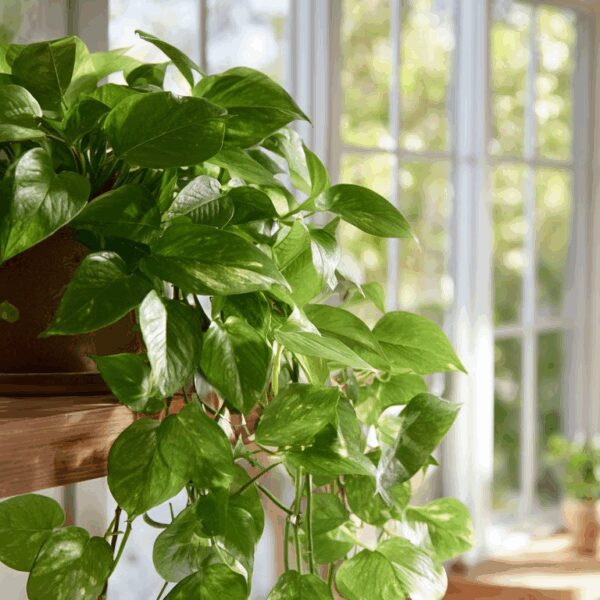As the leaves turn and that chilly October breeze sets in, it’s time to chat about Fall Plant Care. You might be wondering which of your beloved outdoor beauties can make the leap indoors—trust me, it’s not just about saving them from frost; it’s about keeping that green thumb happy all winter long!
🌱 Green Thumb Essentials in 4 Points:
- Know Your Plants! 🪴 Before the frost hits, bring in your tropical darlings like hibiscus and fiddle-leaf figs. If temps dip below 50°F, they’re coming inside. Check that forecast—first frosts can be sneaky!
- TLC Before the Move 💧 Give your plants a little love before hauling them indoors. Check for pests (no one wants unwanted guests!) and prune any dead leaves. And hey, let that soil dry out a bit if it’s been soaking up summer rain.
- Light Matters ☀️ Indoor lighting can be tricky! Aim for a bright, sunny spot—south-facing windows are golden. If sunlight’s scarce, don’t hesitate to grab some grow lights. Your plants will thank you for that extra boost!
- Humidity & Watering 💦 Keep an eye on humidity levels; most tropicals love it around 50% or higher. Grouping them together can help create a cozy, humid micro-climate. And remember, as winter rolls in, cut back on watering—let the top inch of soil dry out before giving them another drink.
Deciding Which Plants to Bring Inside
As the crisp air of October settles in, it’s time to start thinking about which of your outdoor plants can make the move indoors. Not every plant needs to come inside, but some definitely do. Tropical plants like hibiscus, bird of paradise, and fiddle-leaf fig are not fans of frost and will suffer if left outside. If your area is expecting temperatures to dip below 50°F, it’s a good idea to bring those beauties inside.
If you’re in zones 7-9, like parts of California or Texas, you might have a bit more leeway. Still, don’t underestimate that first frost—it sneaks up on you! Check your local forecast and keep an eye on those nighttime lows.
Preparing Your Plants for the Move
Before you haul your plants inside, give them a little TLC. First off, inspect them for pests. You don’t want to bring any unwelcome visitors into your home. Give the leaves a thorough check for bugs and treat them with insecticidal soap if necessary. A quick rinse in the shower can also help get rid of dust and pests alike.
Next, prune any dead or yellowing leaves. This helps your plants conserve energy as they adjust to their new environment. And don’t forget to check the soil moisture! If it’s overly wet from the summer rain, let it dry out a bit before bringing it inside.
3 Low-Maintenance Houseplants That Actually Clean Your Indoor Air
Adequate Light Is Key
Your plants are used to soaking up all that glorious sunlight outside. Once they come inside, they’ll need similar care. Choose a bright spot in your home—south-facing windows work best! If natural light is limited, consider investing in grow lights. They’re not just for serious gardeners; even houseplants appreciate that extra boost during the shorter days of winter.
If you’ve got larger plants like rubber trees or palms, just be sure they aren’t blocking any airflow or crowding out other plants in your space.
Temperature and Humidity Considerations
Your cozy home might feel perfect for you, but it can be a bit harsh for some plants. Most tropicals thrive in humidity levels around 50% or higher, which can be tricky during dry winter months. Consider placing a humidifier nearby or grouping plants together—this creates a mini greenhouse effect that boosts humidity naturally.
Watering Needs Change
As the days get shorter and temperatures drop, your plants will slow down and need less water than they did during their summer growth spurt. Keep an eye on them; over-watering is one of the most common ways indoor plants suffer during winter months. A good rule of thumb? Let the top inch of soil dry out before giving them another drink.
Avoiding Shock and Stress
The move indoors can be stressful for plants that are used to being outside all summer long. To ease this transition, try bringing them in at night first before making the full switch. This gradual approach helps minimize shock.
Potted Perennials vs. Annuals: What’s the Difference?
If you’ve got potted perennials like lavender or sedum, these can often survive colder temperatures outdoors if insulated properly with mulch or burlap wrap; just be cautious with frost damage! Annuals, on the other hand—like those vibrant petunias or marigolds—aren’t going to make it through winter no matter how much you try to baby them.
Caring for Perennials Left Outside
If you decide to leave perennials outdoors, remember they still need care! Water them well before the ground freezes; this helps prevent roots from drying out during winter dormancy.
The Joy of Indoor Gardening All Winter Long
Once your plants are settled inside, you’ll discover a whole new rhythm to your gardening routine. Indoor gardening during winter isn’t just about survival—it’s about creating a thriving green sanctuary that lifts your spirits during those gray months. Your pothos, spider plants, and peace lilies will become your winter companions, purifying your air and bringing life to every room.
Rotate your plants every week or so to ensure even growth. They’ll naturally lean toward the light, and turning them helps them develop balanced, beautiful foliage. And don’t be surprised if growth slows down—that’s totally normal! Most plants enter a semi-dormant state during winter, conserving energy until spring arrives.
Common Problems and Quick Fixes
Even with the best care, you might run into a few hiccups. Yellow leaves? Usually a sign of overwatering or insufficient light. Cut back on watering and move the plant closer to a window. Brown leaf tips? That’s often low humidity or fluoride in tap water. Boost humidity with a pebble tray (just a shallow dish with pebbles and water) and consider using filtered water.
Pests can still show up indoors—spider mites, aphids, and fungus gnats are the usual suspects. Catch them early by checking your plants weekly. A spray bottle with diluted neem oil works wonders, and you can grab it at any Home Depot or Lowe’s. For fungus gnats, let the soil dry out more between waterings; they thrive in constantly moist conditions.
Fertilizing During Winter
Here’s something many gardeners get wrong: fertilizing too much in winter. Since most plants aren’t actively growing, they don’t need much food. Cut back to once a month at half strength, or skip it entirely until spring. Your Ficus elastica (rubber plant) and other tropicals will appreciate this lighter approach.
Planning Ahead for Spring
While you’re enjoying your indoor garden, start thinking about spring. Late winter is perfect for starting seeds indoors—tomatoes, peppers, and herbs can all get a head start on your windowsill. By the time May rolls around and the last frost passes, you’ll have strong seedlings ready to transplant outside.
Keep a gardening journal this winter. Note which plants thrived indoors, which struggled, and what adjustments you made. Next fall, you’ll have a personalized playbook for bringing your outdoor plants inside. And honestly? There’s something deeply satisfying about flipping through those notes and seeing your progress as a gardener.
So embrace this transition! Your plants are resilient, and with a little attention and care, they’ll reward you with lush growth and vibrant color all winter long. Come spring, you’ll be ready to move them back outside, stronger and healthier than ever.







